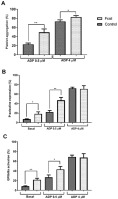当前位置:
X-MOL 学术
›
Free Radical Bio. Med.
›
论文详情
Our official English website, www.x-mol.net, welcomes your
feedback! (Note: you will need to create a separate account there.)
Older adults with frailty syndrome present an altered platelet function and an increased level of circulating oxidative stress and mitochondrial dysfunction biomarker GDF-15.
Free Radical Biology and Medicine ( IF 7.1 ) Pub Date : 2020-01-08 , DOI: 10.1016/j.freeradbiomed.2020.01.007 Diego Arauna 1 , Francisco García 2 , Leocadio Rodríguez-Mañas 3 , Jaume Marrugat 4 , Claudia Sáez 5 , Marcelo Alarcón 1 , Sergio Wehinger 1 , Yolanda Espinosa-Parrilla 6 , Iván Palomo 7 , Eduardo Fuentes 7
Free Radical Biology and Medicine ( IF 7.1 ) Pub Date : 2020-01-08 , DOI: 10.1016/j.freeradbiomed.2020.01.007 Diego Arauna 1 , Francisco García 2 , Leocadio Rodríguez-Mañas 3 , Jaume Marrugat 4 , Claudia Sáez 5 , Marcelo Alarcón 1 , Sergio Wehinger 1 , Yolanda Espinosa-Parrilla 6 , Iván Palomo 7 , Eduardo Fuentes 7
Affiliation

|
INTRODUCTION
The elderly population is increasing worldwide and in Chile, it is expected to grow rapidly. The World Health Organization (WHO) ICOPE guideline (Integrated Care for Older People) emphasizes the importance of frailty diagnosis to prevent dependence. Frailty in older adults is considered an indicator of vulnerability and poor health outcomes, of multifactorial etiology. Our objective was to investigate the association of activation of coagulation and increased risk of thrombosis with frailty in people older than 64 years. A prevalent-case control study was designed with 28 frail older and 27 robust older adults (non-frail, control group) older than 64 years. Frailty was defined by Fried's Phenotype, Platelet aggregation and activation plasma levels of Thromboxane B2 (TXB2), 8-isoprostane and Growth Differentiation Factor-15 (GDF-15) were determined.
RESULTS
Compared to healthy controls, frail older adults, had a) higher percentage of platelet aggregation induction with ADP 4 μM (82.85% (3.35) and 73.41% (3.26), p-value = 0.024) and subaggregant dose of ADP (30.83% (7.47) and 13.25% (3.21), p-value = 0.002); b) higher platelet activation: P-selectin exposure (18.23% (4.41) and 6.96% (1.08), p-value = 0.011), and activated GPIIβ-IIIα (21.51% (3.41) and 8.26% (1.18), p-value = 0.001), at the baseline level and against a subaggregant dose ADP: P-selectin exposure (46.93% (5.95) and 13.41% (3.35), p-value = 0.002) and activated GPIIβ-IIIα (43.29% (6.04) and 26.71% (4.92), p-value = 0.024); c) higher plasma levels of TXB2 (201.8 ng/mL (59.53-236.3) and 45.77 ng/mL (25.14-98.26), p-value<0.0001), d) elevated plasma levels of 8-isoprostane (70.94 pg/mL, IQ: 65.89-99,96 and 56.24 pg/mL, IQ: 42.18-74.81, p-value = 0.001), and e) higher plasma GDF-15 levels (2,379 pg/mL, IQ: 1,845-4,121and 1367 pg/mL, IQ: 1190-1747, p-value = 0.0001).
DISCUSSION
Older adults with frailty syndrome have an upregulated platelet activity that may contribute to an increased risk of thrombosis and aspirin resistance. The elevated oxidative stress and increases of GDF-15 levels might be related to altered platelet responsiveness in frail patients.
CONCLUSION
The determination of biomarkers of platelet dysfunction, oxidative stress and cell senescence/mitochondrial dysfunction may contribute to frailty diagnosis, and approaches aimed at regulating platelet function in frail older adults could contribute to its prevention and treatment.
中文翻译:

患有衰弱综合征的老年人表现出血小板功能改变以及循环氧化应激和线粒体功能障碍生物标志物 GDF-15 水平升高。
引言 世界范围内的老年人口正在增加,在智利,预计将迅速增长。世界卫生组织 (WHO) ICOPE 指南(老年人综合护理)强调了虚弱诊断对预防依赖的重要性。老年人的虚弱被认为是多因素病因的脆弱性和不良健康结果的指标。我们的目的是调查 64 岁以上人群中凝血激活和血栓形成风险增加与虚弱的关系。一项流行病例对照研究设计了 28 名体弱的老年人和 27 名体格健壮的老年人(非体弱,对照组)年龄超过 64 岁。虚弱是由 Fried 的表型、血小板聚集和血栓素 B2 (TXB2) 的活化血浆水平定义的,测定了 8-异前列腺素和生长分化因子 15 (GDF-15)。结果 与健康对照组相比,体弱的老年人 a) ADP 4 μM (82.85% (3.35) 和 73.41% (3.26),p 值 = 0.024) 和亚聚集剂量 ADP (30.83%) 诱导血小板聚集的百分比更高(7.47) 和 13.25% (3.21),p 值 = 0.002);b) 更高的血小板活化:P-选择素暴露 (18.23% (4.41) 和 6.96% (1.08),p 值 = 0.011),以及活化的 GPIIβ-IIIα (21.51% (3.41) 和 8.26% (1.18),p-值 = 0.001),在基线水平和亚聚集剂量 ADP:P-选择素暴露 (46.93% (5.95) 和 13.41% (3.35),p 值 = 0.002) 和激活的 GPIIβ-IIIα (43.29% (6.04)和 26.71% (4.92),p 值 = 0.024);c) 较高的 TXB2 血浆水平 (201.8 ng/mL (59.53-236.3) 和 45.77 ng/mL (25.14-98.26),p 值<0.0001),d) 血浆 8-异前列腺素水平升高(70.94 pg/mL,IQ:65.89-99,96 和 56.24 pg/mL,IQ:42.18-74.81,p 值 = 0.001),和 e) 血浆 GDF-15 水平升高(2,379 pg/mL,IQ:1,845-4,121 和 1367 pg/mL,IQ:1190-1747,p 值 = 0.0001)。讨论 患有虚弱综合征的老年人血小板活性上调,这可能导致血栓形成和阿司匹林抵抗的风险增加。氧化应激升高和 GDF-15 水平升高可能与体弱患者的血小板反应性改变有关。结论 血小板功能障碍、氧化应激和细胞衰老/线粒体功能障碍生物标志物的测定可能有助于衰弱的诊断,旨在调节衰弱老年人血小板功能的方法有助于其预防和治疗。94 pg/mL, IQ: 65.89-99,96 和 56.24 pg/mL, IQ: 42.18-74.81, p-value = 0.001), 和 e) 更高的血浆 GDF-15 水平 (2,379 pg/mL, IQ: 1,845- 4,121 和 1367 pg/mL,IQ:1190-1747,p 值 = 0.0001)。讨论 患有虚弱综合征的老年人血小板活性上调,这可能导致血栓形成和阿司匹林抵抗的风险增加。氧化应激升高和 GDF-15 水平升高可能与体弱患者的血小板反应性改变有关。结论 血小板功能障碍、氧化应激和细胞衰老/线粒体功能障碍生物标志物的测定可能有助于衰弱的诊断,旨在调节衰弱老年人血小板功能的方法有助于其预防和治疗。94 pg/mL, IQ: 65.89-99,96 和 56.24 pg/mL, IQ: 42.18-74.81, p-value = 0.001), 和 e) 更高的血浆 GDF-15 水平 (2,379 pg/mL, IQ: 1,845- 4,121 和 1367 pg/mL,IQ:1190-1747,p 值 = 0.0001)。讨论 患有虚弱综合征的老年人血小板活性上调,这可能导致血栓形成和阿司匹林抵抗的风险增加。氧化应激升高和 GDF-15 水平升高可能与体弱患者的血小板反应性改变有关。结论 血小板功能障碍、氧化应激和细胞衰老/线粒体功能障碍生物标志物的测定可能有助于衰弱的诊断,旨在调节衰弱老年人血小板功能的方法有助于其预防和治疗。e) 更高的血浆 GDF-15 水平(2,379 pg/mL,IQ:1,845-4,121 和 1367 pg/mL,IQ:1190-1747,p 值 = 0.0001)。讨论 患有虚弱综合征的老年人血小板活性上调,这可能导致血栓形成和阿司匹林抵抗的风险增加。氧化应激升高和 GDF-15 水平升高可能与体弱患者的血小板反应性改变有关。结论 血小板功能障碍、氧化应激和细胞衰老/线粒体功能障碍生物标志物的测定可能有助于衰弱的诊断,旨在调节衰弱老年人血小板功能的方法有助于其预防和治疗。e) 更高的血浆 GDF-15 水平(2,379 pg/mL,IQ:1,845-4,121 和 1367 pg/mL,IQ:1190-1747,p 值 = 0.0001)。讨论 患有虚弱综合征的老年人血小板活性上调,这可能导致血栓形成和阿司匹林抵抗的风险增加。氧化应激升高和 GDF-15 水平升高可能与体弱患者的血小板反应性改变有关。结论 血小板功能障碍、氧化应激和细胞衰老/线粒体功能障碍生物标志物的测定可能有助于衰弱的诊断,旨在调节衰弱老年人血小板功能的方法有助于其预防和治疗。讨论 患有虚弱综合征的老年人血小板活性上调,这可能导致血栓形成和阿司匹林抵抗的风险增加。氧化应激升高和 GDF-15 水平升高可能与体弱患者的血小板反应性改变有关。结论 血小板功能障碍、氧化应激和细胞衰老/线粒体功能障碍生物标志物的测定可能有助于衰弱的诊断,旨在调节衰弱老年人血小板功能的方法有助于其预防和治疗。讨论 患有虚弱综合征的老年人血小板活性上调,这可能导致血栓形成和阿司匹林抵抗的风险增加。氧化应激升高和 GDF-15 水平升高可能与体弱患者的血小板反应性改变有关。结论 血小板功能障碍、氧化应激和细胞衰老/线粒体功能障碍生物标志物的测定可能有助于衰弱的诊断,旨在调节衰弱老年人血小板功能的方法有助于其预防和治疗。
更新日期:2020-01-09
中文翻译:

患有衰弱综合征的老年人表现出血小板功能改变以及循环氧化应激和线粒体功能障碍生物标志物 GDF-15 水平升高。
引言 世界范围内的老年人口正在增加,在智利,预计将迅速增长。世界卫生组织 (WHO) ICOPE 指南(老年人综合护理)强调了虚弱诊断对预防依赖的重要性。老年人的虚弱被认为是多因素病因的脆弱性和不良健康结果的指标。我们的目的是调查 64 岁以上人群中凝血激活和血栓形成风险增加与虚弱的关系。一项流行病例对照研究设计了 28 名体弱的老年人和 27 名体格健壮的老年人(非体弱,对照组)年龄超过 64 岁。虚弱是由 Fried 的表型、血小板聚集和血栓素 B2 (TXB2) 的活化血浆水平定义的,测定了 8-异前列腺素和生长分化因子 15 (GDF-15)。结果 与健康对照组相比,体弱的老年人 a) ADP 4 μM (82.85% (3.35) 和 73.41% (3.26),p 值 = 0.024) 和亚聚集剂量 ADP (30.83%) 诱导血小板聚集的百分比更高(7.47) 和 13.25% (3.21),p 值 = 0.002);b) 更高的血小板活化:P-选择素暴露 (18.23% (4.41) 和 6.96% (1.08),p 值 = 0.011),以及活化的 GPIIβ-IIIα (21.51% (3.41) 和 8.26% (1.18),p-值 = 0.001),在基线水平和亚聚集剂量 ADP:P-选择素暴露 (46.93% (5.95) 和 13.41% (3.35),p 值 = 0.002) 和激活的 GPIIβ-IIIα (43.29% (6.04)和 26.71% (4.92),p 值 = 0.024);c) 较高的 TXB2 血浆水平 (201.8 ng/mL (59.53-236.3) 和 45.77 ng/mL (25.14-98.26),p 值<0.0001),d) 血浆 8-异前列腺素水平升高(70.94 pg/mL,IQ:65.89-99,96 和 56.24 pg/mL,IQ:42.18-74.81,p 值 = 0.001),和 e) 血浆 GDF-15 水平升高(2,379 pg/mL,IQ:1,845-4,121 和 1367 pg/mL,IQ:1190-1747,p 值 = 0.0001)。讨论 患有虚弱综合征的老年人血小板活性上调,这可能导致血栓形成和阿司匹林抵抗的风险增加。氧化应激升高和 GDF-15 水平升高可能与体弱患者的血小板反应性改变有关。结论 血小板功能障碍、氧化应激和细胞衰老/线粒体功能障碍生物标志物的测定可能有助于衰弱的诊断,旨在调节衰弱老年人血小板功能的方法有助于其预防和治疗。94 pg/mL, IQ: 65.89-99,96 和 56.24 pg/mL, IQ: 42.18-74.81, p-value = 0.001), 和 e) 更高的血浆 GDF-15 水平 (2,379 pg/mL, IQ: 1,845- 4,121 和 1367 pg/mL,IQ:1190-1747,p 值 = 0.0001)。讨论 患有虚弱综合征的老年人血小板活性上调,这可能导致血栓形成和阿司匹林抵抗的风险增加。氧化应激升高和 GDF-15 水平升高可能与体弱患者的血小板反应性改变有关。结论 血小板功能障碍、氧化应激和细胞衰老/线粒体功能障碍生物标志物的测定可能有助于衰弱的诊断,旨在调节衰弱老年人血小板功能的方法有助于其预防和治疗。94 pg/mL, IQ: 65.89-99,96 和 56.24 pg/mL, IQ: 42.18-74.81, p-value = 0.001), 和 e) 更高的血浆 GDF-15 水平 (2,379 pg/mL, IQ: 1,845- 4,121 和 1367 pg/mL,IQ:1190-1747,p 值 = 0.0001)。讨论 患有虚弱综合征的老年人血小板活性上调,这可能导致血栓形成和阿司匹林抵抗的风险增加。氧化应激升高和 GDF-15 水平升高可能与体弱患者的血小板反应性改变有关。结论 血小板功能障碍、氧化应激和细胞衰老/线粒体功能障碍生物标志物的测定可能有助于衰弱的诊断,旨在调节衰弱老年人血小板功能的方法有助于其预防和治疗。e) 更高的血浆 GDF-15 水平(2,379 pg/mL,IQ:1,845-4,121 和 1367 pg/mL,IQ:1190-1747,p 值 = 0.0001)。讨论 患有虚弱综合征的老年人血小板活性上调,这可能导致血栓形成和阿司匹林抵抗的风险增加。氧化应激升高和 GDF-15 水平升高可能与体弱患者的血小板反应性改变有关。结论 血小板功能障碍、氧化应激和细胞衰老/线粒体功能障碍生物标志物的测定可能有助于衰弱的诊断,旨在调节衰弱老年人血小板功能的方法有助于其预防和治疗。e) 更高的血浆 GDF-15 水平(2,379 pg/mL,IQ:1,845-4,121 和 1367 pg/mL,IQ:1190-1747,p 值 = 0.0001)。讨论 患有虚弱综合征的老年人血小板活性上调,这可能导致血栓形成和阿司匹林抵抗的风险增加。氧化应激升高和 GDF-15 水平升高可能与体弱患者的血小板反应性改变有关。结论 血小板功能障碍、氧化应激和细胞衰老/线粒体功能障碍生物标志物的测定可能有助于衰弱的诊断,旨在调节衰弱老年人血小板功能的方法有助于其预防和治疗。讨论 患有虚弱综合征的老年人血小板活性上调,这可能导致血栓形成和阿司匹林抵抗的风险增加。氧化应激升高和 GDF-15 水平升高可能与体弱患者的血小板反应性改变有关。结论 血小板功能障碍、氧化应激和细胞衰老/线粒体功能障碍生物标志物的测定可能有助于衰弱的诊断,旨在调节衰弱老年人血小板功能的方法有助于其预防和治疗。讨论 患有虚弱综合征的老年人血小板活性上调,这可能导致血栓形成和阿司匹林抵抗的风险增加。氧化应激升高和 GDF-15 水平升高可能与体弱患者的血小板反应性改变有关。结论 血小板功能障碍、氧化应激和细胞衰老/线粒体功能障碍生物标志物的测定可能有助于衰弱的诊断,旨在调节衰弱老年人血小板功能的方法有助于其预防和治疗。











































 京公网安备 11010802027423号
京公网安备 11010802027423号